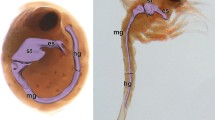Abstract
We studied the ultrastructure of the digestive system in late doliolaria, pentactula, and 1-month-old juvenile of the holothurian Apostichopus japonicus. In late doliolaria and pentactula, the digestive system is divided into three segments: pharynx, gut, and cloaca. Pharynx and the posterior part of cloaca are lined by cuticular epithelium and apparently of ectodermal origin. The anterior part of cloaca and the entire gut is not differentiated histologically and is lined by a single type of digestive cells, vesicular enterocytes I. These cells are characterized by large secretory granules, containing an acidic substance, found in cytoplasm. As the anterior part of the cloaca is lined by cells typical of the endodermal segment of digestive tube (vesicular enterocytes I), we suggest this part to be of endodermal origin and probably formed from the larval stomach. In 1-month-old juveniles, the structure of the digestive system grows more complicated. In addition to vesicular enterocytes I, three more types of enterocytes appear in luminal epithelium. The specific distribution of the four types of digestive cells divides the intestine into three parts, each probably performing its own function. All enterocytes develop long microvilli, which indicate the intensification of the extracellular digestion processes and an increased absorption of dissolved nutrients.










Similar content being viewed by others
References
Brusca RC, Brusca GJ (2003) Invertebrates, 2nd edn. Sinauer Associates, Sunderland
Dolmatov IY, Ginanova TT (2009) Post-autotomy regeneration of the respiratory trees in the holothurian Apostichopus japonicus (Holothurioidea, Aspidochirotida). Cell Tissue Res 336:41–58
Dolmatov IY, Mokretsova ND (1995) Morphology of pentactula Cucumaria japonica (Dendrochirota, Holothuroidea). Zool Zh 74:83–91
Dolmatov IY, Frolova LT, Zakharova EA, Ginanova TT (2011) Development of respiratory trees in the holothurian Apostichopus japonicus (Aspidochirotida: Holothuroidea). Cell Tissue Res 346:327–338
Dolmatov IY, Ginanova TT, Frolova LT (2016) Metamorphosis and definitive organogenesis in the holothurian Apostichopus japonicus. Zoomorphology 135:173–188. doi:10.1007/s00435-015-0299-y
Drozdov AL, Kornienko ES, Kruchkova GA (1990) Oocyte maturation, development and metamorphosis in the Far-eastern sea cucumber. Sov J Mar Biol 16:347–355
Emlet RB (2016) The nonfeeding auricularia of Holothuria mexicana (Echinodermata, Holothuroidea). Invertebr Biol 135:245–251. doi:10.1111/ivb.12136
Feral JP (1989) Activity of the principal digestive enzymes in the detritivorous apodous holothuroid Leptosynapta galliennei and two other shallow-water holothuroids. Mar Biol 101:367–379
Feral JP, Massin C (1982) Digestive systems: Holothuroidea. In: Jangoux M, Lawrence JM (eds) Echinoderm nutrition. Balkema, Rotterdam, pp 191–212
Filimonova GF, Tokin IB (1980) Structural and functional peculiarities of the digestive system of Cucumaria frondosa (Echinodermata: Holothuroidea). Mar Biol 60:9–16. doi:10.1007/BF00395601
Frolova LT, Dolmatov IY (2010) Microscopic anatomy of the digestive system in normal and regenerating specimens of the brittlestar Amphipholis kochii. Biol Bull 218:303–316
Heinzeller T, Welsch U (1994) Crinoidea. In: Harrison FW, Chia FS (eds) Microscopic anatomy of invertebrates, vol 14., EchinodermataWiley, New York, pp 9–148
Hyman LH (1955) The invertebrates: Echinodermata. The coelome Bilateria. McGraw-Hill Book Co., New York
Ivanova-Kazas OM (1978) Comparative embryology of invertebrates. Echinodermata and Hemichordata, Nauka, Moscow
Kamenev YO, Dolmatov IY, Frolova LT, Khang NA (2013) The morphology of the digestive tract and respiratory organs of the holothurian Cladolabes schmeltzii (Holothuroidea, Dendrochirotida). Tissue Cell 45:126–139. doi:10.1016/j.tice.2012.10.002
Kawaguti S (1964) Electron microscopy on the intestinal wall of the sea cucumber with special attention to its muscle and nerve plexus. Biol J Okayama Univ 10:39–50
Lacalli TC, West JE (2000) The auricularia-to-doliolaria transformation in two aspidochirote holothurians, Holothuria mexicana and Stichopus californicus. Invertebr Biol 119:421–432. doi:10.1111/j.1744-7410.2000.tb00112.x
Malakhov VV, Cherkasova IV (1991) The embryonal and early larval development of Stichopus japonicus var. armatus (Aspidochirota, Stichopodidae). Zool Zh 70:55–67
Malakhov VV, Cherkasova IV (1992) Metamorphosis of the sea cucumber Stichopus japonicus (Aspidochirota, Stichopodidae). Zool Zh 71:11–21
Mashanov VS, Dolmatov IY (2001) Ultrastructure of the alimentary canal in five-month-old pentactulae of the holothurian Eupentacta fraudatrix. Russ J Mar Biol 27:320–328
Mashanov VS, Dolmatov IY (2004) Functional morphology of the developing alimentary canal in the holothurian Eupentacta fraudatrix (Holothuroidea, Dendrochirota). Acta Zool Stockholm 85:29–39. doi:10.1111/j.0001-7272.2004.00155.x
Mashanov VS, Frolova LT, Dolmatov IY (2004) Structure of the digestive tube in the holothurian Eupentacta fraudatrix (Holothuroidea, Dendrochirota). Russ J Mar Biol 30:314–322
Mozzi D, Dolmatov IY, Bonasoro F, Candia Carnevali MD (2006) Visceral regeneration in the crinoid Antedon mediterranea: basic mechanisms, tissues and cells involved in gut regrowth. Centr Eur J Biol 1:609–635
Podkorytov AG, Maslennikov SI (2015) The distribution of the far eastern trepang Apostichopus japonicus (Selenka, 1867) in the open aquatic area of Amur Bay (Sea of Japan) in terms of commercial load. Water: Chemistry and ecology: 55–62
Purcell SW, Samyn Y, Conand C (2012) Commercially important sea cucumbers of the world. FAO species catalogue for fishery purposes. No. 6. FAO, Rome
Shinn GL, Stricker SA, Cavey MJ (1990) Ultrastructure of transrectal coelomoducts in the sea cucumber Parastichopus californicus (Echinodermata, Holothuroida). Zoomorphology 109:189–199. doi:10.1007/bf00312470
Smiley S (1986) Metamorphosis of Stichopus californicus (Echinodermata: Holothuroidea) and its phylogenetic implications. Biol Bull 171:611–631
Smiley S (1994) Holothuroidea. In: Harrison FW, Chia FS (eds) Microscopic anatomy of invertebrates, vol 14., EchinodermataWiley, New York, pp 401–471
Smiley S, McEuen FS, Chaffee C, Krishnan S (1991) Echinodermata: holothuroidea. In: Giese AC, Pearse JS, Pearse VB (eds) Reproduction of marine invertebrates, vol 6. Boxwood, Pacific Grove, pp 633–750
Uthicke S, Byrne M, Conand C (2010) Genetic barcoding of commercial Bêche-de-mer species (Echinodermata: Holothuroidea). Mol Ecol Resour 10:634–646
Yang H, Hamel J-F, Mercier A (2015) The sea cucumber Apostichopus japonicus. History, biology and aquaculture. Elsevier, Amsterdam
Yushin VV, Bukhartseva NV, Malakhov VV (1993) Electrone microscope study of development of the sea cucumber Stichopus japonicus (Echinodermata: Holothuroidea) from the hatched blastula through dipleurula. Tsitologiya 35:22–29
Acknowledgements
This study was supported by the Russian Science Foundation (Grant No. 14-50-00034).
Author information
Authors and Affiliations
Corresponding author
Rights and permissions
About this article
Cite this article
Dolmatov, I.Y., Ginanova, T.T. & Frolova, L.T. Digestive system formation during the metamorphosis and definitive organogenesis in Apostichopus japonicus . Zoomorphology 136, 191–204 (2017). https://doi.org/10.1007/s00435-016-0340-9
Received:
Revised:
Accepted:
Published:
Issue Date:
DOI: https://doi.org/10.1007/s00435-016-0340-9




